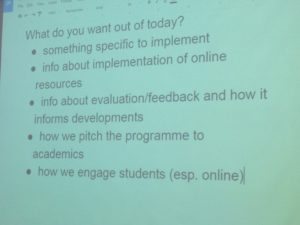 Emma Woods, CILIP IL Group Marketing Officer and an Information Consultant at Royal Holloway, gives her thoughts on the Developing a Blended Learning Skills Programme workshop, held at CILIP on 26th March 2015. This workshop was organised by the CILIP IL Group and run by Jade Kelsall and Jennie Blake from the University of Manchester.
Emma Woods, CILIP IL Group Marketing Officer and an Information Consultant at Royal Holloway, gives her thoughts on the Developing a Blended Learning Skills Programme workshop, held at CILIP on 26th March 2015. This workshop was organised by the CILIP IL Group and run by Jade Kelsall and Jennie Blake from the University of Manchester.
I was delighted to be able to attend this event, having heard the rave reviews from when it was held in Manchester. Jade and Jennie did not disappoint!
 After a brief talk from myself on why to join the CILIP IL Group, Jennie kicked things off by asking what we wanted to gain from the day. After a few moments of silence, quite a few suggestions were made.
After a brief talk from myself on why to join the CILIP IL Group, Jennie kicked things off by asking what we wanted to gain from the day. After a few moments of silence, quite a few suggestions were made.
At Manchester they run both face-to-face workshops (organised by Jennie and delivered by around 60 members of staff) and offer a suite of around 40 online resources, which Jade has been developing since taking up her post. These are branded as My Learning Essentials and cover a range of skills, including academic writing, reference management and team work. The aim of these is to make students independent by changing their expectations. Before, many students were relying too heavily on 1-2-1 training from the Library, which was very demanding on staff time. During induction, librarians can push towards the online resources, and then students can decide whether to supplement their learning by attending a workshop. The content in the online resources and the workshops does not overlap.
Jennie talked about the process they go through to decide whether to make a new online resource. From identifying a need (from student/academic feedback and the most popular courses), to review (is there sufficient need?, is it appropriate for online delivery?) to developing the new resource. I thought this was very interesting, as there can be a temptation to put anything online, particularly if it’s popular. However, it’s important to stop and think if it’s appropriate for that topic or whether a face to face workshop is the better method of delivery.
In our table groups, we were asked to think of a topic we would like to run a session on and to come up with a learning objective. My table chose keywords. We were asked to consider the following:
- What do you want them to DO, and in what CONTEXT?
- What do you want them to KNOW to enable that?
- How do you want them to FEEL about what they do?
Jennie suggested it sometimes helps to start with 2. This section is where students can pick up transferable skills but developers need to bear in mind that many will need permission to use these skills somewhere else. It’s therefore vital to build in time for reflection.
The next stage is the lesson plan and again we worked on this in our groups. The most helpful tip I gained from this was to tag the lesson plan – if you have too many tags, that’s a sign you’re trying to do too much in the time available! In relation to the activities, it’s helpful to consider:
- Which learning objective is this topic addressing?
- How important is this topic?
- What activity is appropriate for this topic in the time available?
- How does the activity connect to the next thing?
The next stage is to create a storyboard. After this is completed, the online resource can be developed, which usually takes a lot less time than the planning stage. At Manchester, they have a quality assurance process, whereby 2 people look at the resource, at least one of whom has had no prior input.
I thought their way of getting workshop feedback sounds good. At the end of the workshop they ask “impact questions” – how useful students found it and how they will apply what they’ve learnt. Then a more evaluative questionnaire is sent out.
I really liked the way Jennie used her teaching tips on us, for example:
- Instead of shouting “quiet please” to a large room, just ask the people closest “can I have your attention please?” a few times and when they go quiet this spreads throughout the room.
- Don’t be afraid of interrupting discussion – this is a sign that things are going well.
- Use an unexpected number of minutes for class activates (e.g. 3 minutes instead of 5) – this keeps people engaged.
I clearly haven’t done Jade and Jennie’s session justice in this short report but if they run this training again, I strongly urge you to attend! It’s certainly given me plenty of food for thought, as well as increased determination to work more closely with colleagues outside the library in developing online resources and workshops that truly join up so that students have one place to find what they need.
